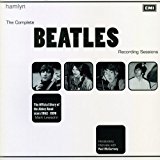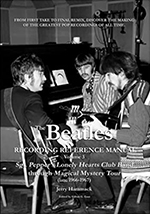Recording "Sgt. Pepper's Lonely Hearts Club Band"
Nov 24, 1966 - Apr 20, 1967 • Songs recorded during this session appear on Sgt. Pepper's Lonely Hearts Club Band (UK Mono)
Recording studio: EMI Studios, Studio Two, Abbey Road • London • UK
Interview Mar 07, 1967 • Paul McCartney interview for Granada Television
Session Mar 09, 1967 • Recording "Getting Better"
Session Mar 10, 1967 • Recording "Getting Better"
Session Mar 13, 1967 • Recording "Good Morning Good Morning"
Article Mar 15, 1967 • Peter Blake and Jann Haworth have dinner at Paul’s
AlbumSome of the songs worked on during this session were first released on the "Sgt. Pepper's Lonely Hearts Club Band (UK Mono)" LP
The previous day, March 9, 1967, The Beatles began recording Paul McCartney’s song “Getting Better.” During this session, engineers Geoff Emerick and Richard Lush were not present, and were replaced by Malcolm Addey and Ken Townsend, assisted by Graham Kirkby. They recorded the basic track and ended the session with a reduction mix, called Take 12, where all the instruments were placed on track one.
On this day, March 10, Geoff Emerick and Richard Lush returned, and various overdubs were added onto Take 12 during a 7 pm – 4 am session. Paul McCartney recorded a bass part and Ringo Starr added snare and hi-hat to reinforce the drum part recorded the previous day. Those parts were double-tracked and filled tracks two and three. George Harrison then added a droning tamboura part on track four.
Additionally, according to Geoff Emerick, “George Martin added an interesting new texture, by playing selected notes on a Virginal, a miniature harpsichord which he owned and brought in specially for the session.” George Martin however mentions that he “played the piano — with a mallet. Not great fun for the piano, maybe — getting bashed right in the vitals — but a great sound, which was just right.“
The state of “Getting Better” at the end of this session was released in the 2017 “Sgt. Pepper’s Lonely Hearts Club Band” box set.
Work on “Getting Better” continued on March 21, 1967.
Malcolm Addey – he of the cigar and never-ending chatter – filled in for me that evening… Ken Townsend was recruited to substitute for Richard [Lush]. Ken was really a maintenance engineer, but I suppose George [Martin] just wanted a familiar face around, someone whom the group had at least met before.
I suspected that the four Beatles were annoyed that I wasn’t there – there was no way they wanted a stranger engineering their sessions – and the next night, when I returned, my suspicions were confirmed.
“Glad to have you back, Geoff,” George Harrison said as soon as he walked in the door. Malcolm had clearly gotten on his nerves.
When we played back the tapes of the previous evening’s work in the control room, Ringo chimed in. “The drums sound a bit naff, don’t you think?”
George Harrison didn’t even wait for an answer. “Little wonder, considering that Malcolm didn’t shut up long enough to get a decent drum sound.”
I had to agree with Ringo’s opinion, but I was surprised that he hadn’t said anything to Addey the night before, because he usually wasn’t shy about expressing his opinion if he heard something he didn’t like. Perhaps he just couldn’t get a word in edgewise! Malcolm had obviously utilized his own setup for recording the drums. Territorial as he was, there was no way he was going to use my configuration. I thought the snare sound was especially lacking, and it took a lot of work during the mixing stage to get the track to fit in sonically with the rest of the album.
That night, George Harrison was overdubbing his tamboura, which may have been another reason why he was in a good mood and was being unusually friendly toward me. Other than the Ravi Shankar session, pretty much the only time I interacted with him was when I was twiddling the controls of his guitar amplifier down in the studio to get sounds; often just the minutest adjustment made a huge sonic difference. The Beatles didn’t have a lot of gear in the studio: apart from Ringo’s drum kit, there were a dozen or so guitars and three or four guitar amps, and that was about it. But everything was tube — there wasn’t a transistor in sight — and that had a lot to do with how good the guitar and bass sounds were.
Geoff Emerick – From “Here, There and Everywhere: My Life Recording the Music of The Beatles“, 2006
After we finished the overdubs on “Getting Better’ — George Harrison playing a drone on tamboura, Ringo on open hi-hat, and George Martin adding an interesting new texture by playing selected notes on a Virginal (a miniature harpsichord which he owned and brought in specially for the session ) — the three of them, plus John, headed out the door; it had been a tiring session and it was well past midnight. But it was a Friday, with a whole weekend ahead to recover, so Paul decided to stay behind with Richard and me, and we dutifully pulled his amp out into the middle of the room for another long marathon of laying down the bass part. I decided to surreptitiously add just a touch of reverb to the bass that night, using the bathroom as an acoustic echo chamber. It was an effect that Paul normally didn’t like, but I was looking for a little extra roundness, so I decided to try it. When he heard the playback, Paul immediately realized what I had done and screwed his face up, but he went along with it for just that one song.
Geoff Emerick – From “Here, There and Everywhere: My Life Recording the Music of The Beatles“, 2006
After two nights of not very productive work I transferred our first, four-track tape to a second, creating a new basic master. This had most of the backing on Track 1, but I kept the drums and bass guitar separate on Track 2. Meanwhile, on Track 3 we added piano and the tamboura. I played the piano — with a mallet. Not great fun for the piano, maybe — getting bashed right in the vitals — but a great sound, which was just right.
George Martin – From “With A Little Help From My Friends: The Making of Sgt. Pepper“, 1995 – This doesn’t match what other authors like Mark Lewisohn, Jerry Hammack, Kevin Howlett or Geoff Emerick said about this particular session.
Recording • SI onto take 12
AlbumOfficially released on Sgt. Pepper's Lonely Hearts Club Band (50th anniversary boxset)
The Complete Beatles Recording Sessions • Mark Lewisohn

The definitive guide for every Beatles recording sessions from 1962 to 1970. We owe a lot to Mark Lewisohn for the creation of those session pages, but you really have to buy this book to get all the details - the number of takes for each song, who contributed what, a description of the context and how each session went, various photographies... And an introductory interview with Paul McCartney!
The Beatles Recording Reference Manual: Volume 3: Sgt. Pepper's Lonely Hearts Club Band through Magical Mystery Tour (late 1966-1967)

The third book of this critically - acclaimed series, nominated for the 2019 Association for Recorded Sound Collections (ARSC) award for Excellence In Historical Recorded Sound, "The Beatles Recording Reference Manual: Volume 3: Sgt. Pepper's Lonely Hearts Club Band through Magical Mystery Tour (late 1966-1967)" captures the band's most innovative era in its entirety. From the first take to the final remix, discover the making of the greatest recordings of all time. Through extensive, fully-documented research, these books fill an important gap left by all other Beatles books published to date and provide a unique view into the recordings of the world's most successful pop music act.
If we modestly consider the Paul McCartney Project to be the premier online resource for all things Paul McCartney, it is undeniable that The Beatles Bible stands as the definitive online site dedicated to the Beatles. While there is some overlap in content between the two sites, they differ significantly in their approach.

Notice any inaccuracies on this page? Have additional insights or ideas for new content? Or just want to share your thoughts? We value your feedback! Please use the form below to get in touch with us.